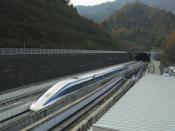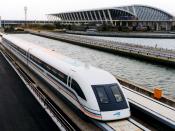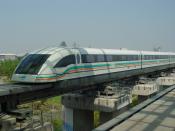Magnetically levitated ground transportation, or 'maglev,' is an advanced mode of
surface high speed transportation whereby a vehicle gliding above a guide track is
suspended, guided, and propelled by magnetic forces. Because they never touch the guide
track causing friction, maglev vehicles can be designed to travel at extremely high speeds,
500 kilometers per hour (300 miles per hour), or more!
Americans traveled 3.2 trillion passenger kilometers (2 trillion passenger miles) by
car, truck, bus, and public transit, and 9.8 billion passenger kilometers (6.1 billion
passenger miles) on Amtrak. As populations have grown the traditional systems have
become stressed. Congestion on highways and at airports not only wastes time and fuel
and increases pollution, but constrains mobility to the extent that economic growth and
productivity are adversely affected.
Increased demand. Between 1980 and 1990, with deregulation and consumer
demand for fast inner-city travel leading to lower airline fares, commercial air traffic has
increased by 56 percent.
Adding to the congestion and delay is increased commuter and
regional air traffic. Those short distance flights take valuable landing slots that could be
used for larger planes on more profitable, longer flights. With the maglev vehicles the
shorter trips excluding access time can be cut a lot. With a study of 16 major corridors of
travel, less than 300 miles in length, they studied how well the maglev vehicles could help,
and in 10 out of the 16 the time could be cut at least slightly. Also the cost of a maglev
trip will be less so that even with the longer trips where the maglev vehicles don't have the
time advantage they will have the cost advantage.
Because land is costly and scarce, adding more highway lanes and building new
airports in or near our larger cities is becoming increasingly difficult. For...


